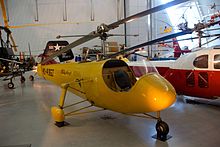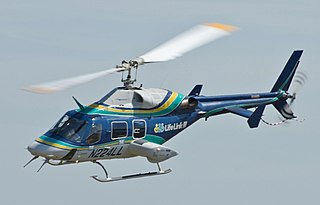
The Bell 222 is an American twin-engine light helicopter built by Bell Helicopter. The Bell 230 is an improved development with different engines and other minor changes.

The Bell 407 is a four-blade, single-engine, civil utility helicopter. A derivative of the Bell 206L-4 LongRanger, the 407 uses the four-blade, soft-in-plane design rotor with composite hub developed for the United States Army's OH-58D Kiowa Warrior instead of the two-blade, semi-rigid, teetering rotor of the 206L-4.

The Bell 47 is a single-rotor single-engine light helicopter manufactured by Bell Helicopter. It was based on the third Bell 30 prototype, which was the company's first helicopter designed by Arthur M. Young. The 47 became the first helicopter certified for civilian use on 8 March 1946. The first civilian delivery was made on 31 December 1946 to Helicopter Air Transport. More than 5,600 Bell 47s were produced, including those under license by Agusta in Italy, Kawasaki Heavy Industries in Japan, and Westland Aircraft in the United Kingdom. The Bell 47J Ranger is a modified version with a fully enclosed cabin and tail boom.
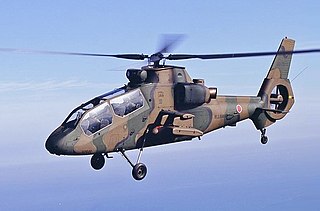
The Kawasaki OH-1 is a military scout/observation helicopter developed and manufactured by the Kawasaki Aerospace Company. The primary operator is the Japan Ground Self-Defense Force (JGSDF), who originally procured the OH-1 as a domestically produced successor to their existing OH-6D Loach fleet. The OH-1 has the distinction of being the first helicopter to be entirely produced in Japan.

The Hiller OH-23 Raven is a three-place, military light observation helicopter based on the Hiller Model 360. The Model 360 was designated by the company as the UH-12, which was first flown in 1948.

A helicopter is a type of rotorcraft in which lift and thrust are supplied by horizontally spinning rotors. This allows the helicopter to take off and land vertically, to hover, and to fly forward, backward and laterally. These attributes allow helicopters to be used in congested or isolated areas where fixed-wing aircraft and many forms of short take-off and landing (STOL) or short take-off and vertical landing (STOVL) aircraft cannot perform without a runway.

The Pitcairn OP-1 was the first rotary-wing aircraft to be seriously evaluated by any of the world's major air forces. The machine was not a helicopter, nor an airplane, but an autogyro. Pitcairn's model was never put into production for any military.

The Westland Westminster was a British helicopter of the 1950s from Westland Aircraft. A large cargo design, it was powered by two turboshaft engines driving a single, five-bladed rotor. Initially unclad, the all-metal airframe was later enclosed in a fabric covering. Designed and built as a private venture without government assistance, it was cancelled when Westland took over rival helicopter producers and their more advanced projects.
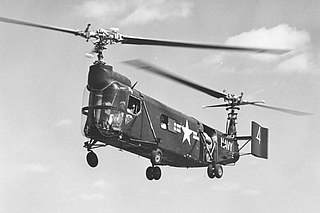
The Bell HSL was an American 1950s anti-submarine warfare (ASW) helicopter built by the Bell Helicopter company, the only tandem rotor type designed by Bell.

The Bell R-12 was an American 1940s military utility helicopter built by the Bell Helicopter company.
The SNCASE SE.3120 Alouette ("Lark") was a utility helicopter developed in France in the early 1950s but which did not enter production. Designed in parallel with the SE.3110, the Alouette shared that machine's dynamic components, with the exception of the SE.3110's unusual twin tail rotor, which was replaced by a single rotor, and the addition of a three-bladed gyroscopic stabiliser under the main rotor (similar to the stabiliser bar used by Bell helicopters. The Alouette featured an open-framework fuselage behind a cockpit that was enclosed by a bubble canopy. Skid undercarriage and tricycle gear were both tested.
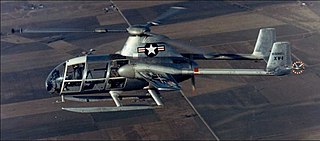
The McDonnell XV-1 is an experimental Convertiplane developed by McDonnell Aircraft for a joint research program between the United States Air Force and the United States Army to explore technologies to develop an aircraft that could take off and land like a helicopter but fly at faster airspeeds, similar to a conventional airplane. The XV-1 would reach a speed of 200 mph, faster than any previous rotorcraft, but the program was terminated due to the tip-jet noise and complexity of the technology which gave only a modest gain in performance.

The Sud-Ouest SO.1221 Djinn is a French two-seat light helicopter designed and manufactured by aircraft manufacturer Sud-Ouest (SNCASO), which was later merged into Sud Aviation. It was the first production French helicopter, as well as being one of the first practical European helicopters to be produced. The Djinn was also the first rotorcraft to harness tip-jet propulsion to enter production.
The Kamov V-80 was a design study designation for an attack helicopter that eventually evolved into the single seat Kamov Ka-50 family of aircraft.
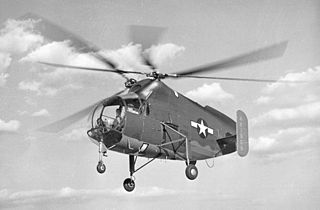
The Kellett XR-8 was a helicopter built in the United States during World War II. It was a two-seat machine intended to demonstrate the feasibility of a twin-rotor system and, while it accomplished this, it also demonstrated a number of problems that prevented further development of this particular design.

The Kellett XR-10 was a military transport helicopter developed in the United States in the 1940s that only flew in prototype form. It was designed in response to a USAAF Technical Instruction issued for the development of a helicopter to transport passengers, cargo, or wounded personnel within an enclosed fuselage. Kellett's proposal followed the general layout that the company was developing in the XR-8, with twin intermeshing rotors, and was accepted by the Air Force on 16 October over proposals by Sikorsky, Bell, and Platt-LePage.

The PZL SM-4 Łątka was a prototype three-seat helicopter of the 1960s, developed by WSK PZL-Świdnik in Poland. Of largely conventional design and construction, a single prototype was built, but was not flown as a result of engine problems.

The Matra-Cantinieau MC-101 was an early 1950s French experimental two seat helicopter of conventional tail rotor configuration but with its engine mounted close to the main rotor, above the seating.

The Transcendental Model 1-G was an experimental American tiltrotor prototype of the 1950s. It was a single-seat aircraft powered by a single piston engine, and was the first tiltrotor to fly. A single example was built, which was destroyed in a crash in 1955.

The 2016 Bell 525 Relentless prototype crash occurred during a test flight on July 6, 2016 near Italy, Texas, destroying the prototype Bell 525 Relentless helicopter and killing the two occupants. The helicopter broke up in flight while traveling about 229 mph (199 kn) at an altitude of about 2,000 feet (610 m); the main rotor contacted and severed the tail boom due to severe vertical oscillations. The crew were performing one engine inoperative (OEI) recovery testing; the test induced a scissors-mode vibration in the main rotor, which resulted in involuntary collective control input. The unintended biomechanical feedback loop exacerbated the vibration, until the rotor contacted the tail-boom.

